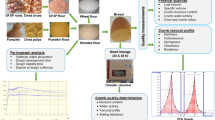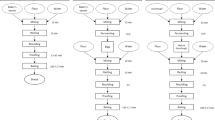Abstract
The aims of this work were to assess the influence of the physicochemical composition of whole flour from soft and hard wheat genotypes on cookie and bread properties, as well as the ability of the prediction tests to estimate the whole meal flour end-use. Flours from hard and soft wheat genotypes proved to have different chemical composition and particle size distribution. Flours from hard wheat had lower particle average size and dietary fiber content, and higher lipid and wet gluten contents than flours from soft wheat. Particle size distribution, water absorption capacity and chemical composition of whole flours strongly influenced bread and cookie making performance. Considering prediction tests, flours from different wheat types were successfully discriminated using SDS-SI, SRC lac, and GI. However, rather weak correlations were found between the prediction test and the cookie and bread quality parameters. The prediction test, standardized for refined flours, showed a poor performance when whole flours were used. Nevertheless, grain texture and whole flour physicochemical properties did affect bread and cookie quality parameters, thus classical prediction tests should be modified in order to estimate the end-use performance of whole flours. Moreover, a standardization of the milling process should be considered.

Similar content being viewed by others
References
AACC International (2010) Approved methods of analysis (11th Ed.). St. Paul, MN (AACC International, Methods 44-15.02, 46-10.01, 08-12.01, 30-25, 32-07.01, 38-10.01, 56-11.02)
Bettge AD, Morris CF, DeMacon VL, Kidwell KK (2002) Adaptation of AACC method 56–11, solvent retention capacity, for use as an early generation selection tool for cultivar development. Cereal Chem 79:670–674
Bressiani J, Oro T, Santetti GS, Almeida JL, Bertolin TE, Gomez M, Gutkoski LC (2017) Properties of whole grain wheat flour and performance in bakery products as a function of particle size. J Cereal Sci 75:269–277
Colombo A, Pérez GT, Ribotta PD, León AE (2008) A comparative study of physicochemical tests for quality prediction of Argentine wheat flours used as corrector flours and for cookie production. J Cereal Sci 48:775–780
Dick J, Quick J (1983) A modified screening test for rapid estimation of gluten strength in early-generation durum wheat breeding lines. Cereal Chemi 60:315–318
Dornez E, Gebruers K, Joye IJ, De Ketelaere B, Lenartz Massaux C, Bodson B, Delcour JA, Courtin CM (2008) Effects of genotype, harvest year and genotype-by-harvest year interactions on arabinoxylan, endoxylanase activity and endoxylanase inhibitor levels in wheat kernels. J Cereal Sci 47:180–189
Gaines CS (2004) Prediction of sugar-snap cookie diameter using sucrose solvent retention capacity, milling softness, and flour protein content. Cereal Chem 81:549–552
Greffeuille V, Abecassis J, Lapierre C, Lullien-Pellerin V (2006) Bran size distribution at milling and mechanical and biochemical characterization of common wheat grain outer layers: a relationship assessment. Cereal Chem 83:641–646
Guttieri MJ, Bowen D, Gannon D, O’Brien K, Souza E (2001) Solvent retention capacities of irrigated soft white spring wheat flours. Crop Sci 41:1054–1061
Guttieri MJ, Becker C, Souza E (2004) Application of wheat meal solvent retention capacity tests within soft wheat breeding populations. Cereal Chem 81:261–266
Hashimoto S, Shogren M, Pomeranz Y (1987) Cereal pentosans: estimation and significance pentosans in wheat and milled wheat products. Cereal Chem 64:30–34
Hong BH, Rubenthaler GL, Allan RE (2000) Wheat pentosans cultivar variation and relationship to kernel hardness. Cereal Chem 66:369–373
Katyal M, Singh N, Singh A, Virdi A, Kaur A, Chopra N, Ahlawat A, Singh AM (2017) Extraordinarily soft, medium-hard and hard Indian wheat varieties: composition, protein profile, dough and baking properties. Food Res Int 100:306–317
Kihlberg I, Johansson L, Kohler A, Risvik E (2004) Sensory qualities of whole wheat pan bread e influence of farming system, milling, and baking technique. J Cereal Sci 39:67–84
Leon AE, Rubiolo O, Añon MC (1996) Use of triticale in cookies: quality factors. Cereal Chem 73:779–784
Li J, Kang J, Wang Li Z, Wang R, Chen ZX, Hou GG (2012) Effect of water migration between arabinoxylans and gluten on baking quality of whole wheat bread detected by magnetic resonance imaging (MRI). J Agr Food Chem 60:6507–6514
Liu C, Liu L, Hao C, Zheng X, Bian K, Zhang J, Wang X (2015) Effects of different milling processes on whole wheat flour quality and performance in steamed bread making. LWT 62:310–318
MacRitchie F (1981) Flour lipids: theoretical aspects and functional properties. Cereal Chem 58:156–158
Moiraghi M, Vanzetti L, Bainotti C, Helguera M, León AE, Pérez GT (2011) Relationship between soft wheat flour physicochemical composition and cookie-making performance. Cereal Chem 88:130–136
Moiraghi M, Vanzetti L, Pflüger L, Helguera M, Pérez GT (2013) Effect of high molecular weight glutenins and rye translocations on soft wheat flour cookie quality. J Cereal Sci 58:424–430
Morris CF (2002) Puroindolines: the molecular genetic basis of wheat grain hardness. Plant Mol Biol 48:633–647
Murray JC, Kiszonas AM, Wilson J, Morris CF (2016) Effect of soft kernel texture on the milling properties of soft durum wheat. Cereal Chem 93:513–517
Noort MW, Daanvan Haaster J, Hemery Y, Henk A, Schols RJ, Hamer R (2010) The effect of particle size of wheat bran fractions on bread quality. evidence for fibre-protein interactions. J Cereal Sci 52:59–64
Pasha I, Anjum FA, Butt MS (2009) Genotypic variation of spring wheats for solvent retention capacities in relation to end-use quality. LWT Food Sci Technol 42:418–423
Pearson T, Wilson J, Gwirtz J, Maglirang E, Dowell F, McCluskey P, Bean S (2007) Relationship between single wheat kernel particle size distribution and Perten SKCS 4100 hardness index. Cereal Chem 84:567–575
Protonotariu S, Batzaki C, Yanniotis S, Mandala I (2016) Effect of jet milled whole wheat flour in biscuits properties. LWT 74:106–113
Ram S, Dawar V, Singh RP, Shoran J (2005) Application of solvent retention capacity tests for the prediction of mixing properties of wheat flour. J Cereal Sci 42:261–266
Seyer ME, Gelinas P (2009) Bran characteristics and wheat performance in whole wheat bread. Int J Food Sci Tech 44:688–693
Souza E, Guttieri MJ, Sneller C (2011) Selecting soft wheat genotypes for whole grain cookies. Crop Sci 51:189–197
Steffolani ME, Ribotta PD, Perez GT, Puppo MC, León AE (2012) Use of enzymes to minimize dough freezing damage. Food Bioprocess Tech 5:2242–2255
Vignola MB, Moiraghi M, Salvucci E, Baroni V, Perez GT (2016) Whole meal and white flour from Argentine wheat genotypes: Mineral and arabinoxylan differences. J Cereal Sci 71:217–223
Wang N, Hou GG, Kweon M, Lee B (2016) Effects of particle size on the properties of whole-grain soft wheat flour and its cracker baking performance. J Cereal Sci 69:187–193
Xiao ZS, Park SH, Chung OK, Caley MS, Seib PA (2006) Solvent retention capacity values in relation to hard winter wheat and flour properties and straight dough breadmaking quality. Cereal Chem 83:465–471
Xion L, Zhang B, Niu M, Zhao S (2017) Protein polymerization and water mobility in whole-wheat dough influenced by bran particle size distribution. LWT 82:396–403
Acknowledgements
This work was supported by the Consejo Nacional de Ciencia y Técnica (CONICET), the Agencia Nacional de Promoción Científica y Tecnológica (ANPCyT) (Project PICT-2012-1060), the Ministerio de Ciencia y Tecnología de la Provincia de Córdoba (Project PID 2018–Res 144/18) and the Secretaria de Ciencia y Técnica (SECYT-UNC) (Project PIP 33620180100595CB).
Author information
Authors and Affiliations
Corresponding author
Additional information
Publisher's Note
Springer Nature remains neutral with regard to jurisdictional claims in published maps and institutional affiliations.
Rights and permissions
About this article
Cite this article
Paesani, C., Moiraghi, M., Sciarini, L. et al. Whole-flours from hard and soft wheat genotypes: study of the ability of prediction test to estimate whole flour end-use. J Food Sci Technol 58, 1462–1469 (2021). https://doi.org/10.1007/s13197-020-04658-1
Revised:
Accepted:
Published:
Issue Date:
DOI: https://doi.org/10.1007/s13197-020-04658-1




